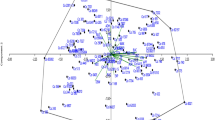Abstract
Cultivars of sesame from 20 countries were sampled for morphological variability. Taximetric methods, including factor, cluster, discriminant, and principal components analyses, established patterns of similarities and were used to generate groupings among the taxa. The complementary results of the analyses indicate that 8 major groups can be discerned. Plants with tetracarpellate capsules have a distinctive form and comprise the initial separation from the entire collection on the dendrogram. The second branch is a group of purple-tinged plants from India that also includes the proposed progenitor. A short, bushy, early maturing genotype consists of predominantly Turkish cultivars. Another group, composed primarily of Korean accessions, consists of unbranched plants with strap-shaped leaves. Other groups are less easily typified. This characterization of the genetic variation in sesame can be used to identify sources of genetic materials for crop improvement, as well as to provide information about the evolution and genetic differentiation of the crop.
Similar content being viewed by others
Literature Cited
Baker, H. G. 1953. Race formation and reproductive method in flowering plants.In Symposia Soc. Expl. Biol., Evolution, No. 7, p. 114–145.
Baum, B. R. 1970. The problem of classifying cultivars with special emphasis on oat(Avena) cultivars. Canad. J. Bot. 48: 1373–1381.
—. 1981. Taxonomy of the infraspecific variability of cultivated plants. Kulturpflanze 29: 209–239.
Bedigian, D., and J. R. Harlan. 1983. Nuba agriculture and ethnobotany, with particular reference to sesame and sorghum. Econ. Bot. 37: 384–395.
—, and —. 1986. Evidence for cultivation of sesame in the ancient world. Econ. Bot. 40: 137–154.
—, D. S. Seigler, and J. R. Harlan. 1985. Sesamin, sesamolin and the origin of sesame. Biochem. Syst. Ecol. 13: 133–139.
Bieber, A. M., Jr., D. W. Brooks, G. Harbottle, and E. V. Sayre. 1976. Application of multivariate techniques to analytical data on Aegean ceramics. Archaeometry 18: 59–74.
Blackith, R. E., and R. A. Reyment. 1971. Multivariate Morphometrics. Academic Press, London.
Burt, R. L. 1983. Observation, classification and description.In J. G. McIvor and R. A. Bray, ed, Genetic Resources of Forage Plants, p. 293–298. Commonwealth Scientific and Industrial Research Organization, East Melbourne, Australia.
Dobzhansky, T., F. J. Ayala, G. L. Stebbins, and J. W. Valentine. 1977. Evolution. Freeman, San Francisco, CA.
Frankel, O. H., and M. E. Soulé. 1981. Conservation and Evolution. Cambridge Univ. Press, Cambridge, England.
Harlan, J. R. 1970. Evolution of cultivated plants.In O. H. Frankel and E. Bennett, ed, Genetic Resources in Plants—Their Exploration and Conservation, p. 19–32. Davis, Philadelphia, PA.
—. 1975. Geographic patterns of variation in some cultivated plants. J. Heredity 66: 182–191.
Harris, R. J. 1975. A Primer of Multivariate Statistics. Academic Press, New York.
Hiltebrandt, V. M. 1932. Sesame(Sesamum indicum L.). Bull. Appl. Bot. Genet. PL Breed. Series 9: 1–114.
Hopke, P. K. 1983. The application of multivariate analysis to environmental data.In D. F. S. Natuoch and P. K. Hopke, ed, Analytical Aspects of Environmental Chemistry, p. 219–262. Wiley, New York.
John, C. M., G. V. Narayana, and C. R. Seshadri. 1950. The wild gingelly of Malabar. Madras Agric. J. 37: 47–50.
Khidir, M. O. 1973. Genetic studies in sesame. II. Inheritance of flower colour and number of locules per pod. Exp. Agric. 9: 361–364.
—, and S. H. El Awad. 1972. Studies on floral biology in sesame. Sudan Agric. J. 7: 17–26.
Krull, C. F., and N. E. Borlaug. 1970. The utilization of collections in plant breeding and production.In O. H. Frankel and E. Bennett, ed, Genetic Resources in Plants—Their Exploration and Conservation, p. 427–439. Davis, Philadelphia, PA.
Langham, D. G. 1945. Genetics of sesame. II. Inheritance of seed pod number, aphid resistance, "yellow leaf," and wrinkled leaves. J. Heredity 36: 245–253.
—. 1947. Genetics of sesame. IV. Some genetic variations in the color of the sesame flower. J. Heredity 38: 221–224.
Laufer, B. 1919. Sesame and flax.In Sino-Iranica. Field Mus. Nat. Hist. Anthropol. Series 15: 288–296.
Martinez, H. D., and V. L. Quilantan. 1963–1964. Percentage of natural cross pollination of sesame in Iguala. Agric. Teen. Mexico 2: 175–177.
Nayar, N. M., and K. L. Mehra. 1970. Sesame: its uses, botany, cytogenetics and origin. Econ. Bot. 24: 20–31.
Nohara, S. 1933. Genetical studies onSesamum indicum L. J. Coll. Agric. Tokyo Univ. 12: 227–386.
Olivier, D. C. 1973. Aggregative Hierarchical Clustering Program Write-up, Preliminary Version. Natl. Bur. Econ. Res., Cambridge, MA.
SAS Institute. 1982. SAS User’s Guide: Statistics. SAS Institute, Cary, NC.
Sikka, A., and A. Gupta. 1949. Pollination studies inSesamum orientale L. Indian J. Agric. Sci. 9: 33–41.
Sneath, P. H. A., and R. R. Sokal. 1973. Numerical Taxonomy. Freeman, San Francisco, CA.
Stebbins, G. L. 1950. Variation and Evolution in Plants. Columbia Univ. Press, New York.
Weiss, E. A. 1971. Castor, Sesame, Safflower. Barnes and Noble, New York.
Williams, W. T. 1983. Analysis of plant evaluation data.In J. G. McIvor and R. A. Bray, ed, Genetic Resources of Forage Plants, p. 293–298. Commonwealth Scientific and Industrial Research Organization, East Melbourne, Australia.
Yermanos, D. M. 1980. Sesame.In W. R. Fehr and H. H. Hadley, ed, Hybridization of Crop Plants, p. 549–563. Agron. Soc. Amer, and Crop Sci. Soc, Madison, WI.
Author information
Authors and Affiliations
Additional information
Part of the dissertation submitted by DB to fulfill the requirements for the Ph.D. in the Department of Agronomy, University of Illinois, Urbana, IL.
Rights and permissions
About this article
Cite this article
Bedigian, D., Smyth, C.A. & Harlan, J.R. Patterns of morphological variation insesamum indicum . Econ Bot 40, 353–365 (1986). https://doi.org/10.1007/BF02858991
Received:
Accepted:
Issue Date:
DOI: https://doi.org/10.1007/BF02858991




